Interview With Hohan Soken: The Last Of The Great Old Time Karate
Warriors – Part 2
Interview by Ernie Estrada
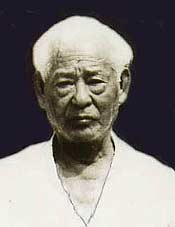
Editor’s
Note: This is the second part of an
interview of Hohan Soken, the great Okinawan karate master, by Ernie
Estrada on September 10, 1978. Estrada: Sensei, you say that Shorin-ryu Matsumura Seito
Karate-do is an old style with many secrets. Since you also say that
you are getting old, what do you feel needs to be passed on to modern
day students of Okinawan karate?
Soken Sensei: There are many secrets in karate that people will never
know and will never understand. These ideas are really not secret if
you train in Okinawa under a good teacher. You will see the teacher use
these so called secret techniques over and over again until they will
become common knowledge to you. Others will look at it and marvel that
it is an advanced or secret technique to them. That is because they do
not have good teachers or their teachers have not researched their respective
styles.
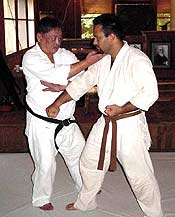 |
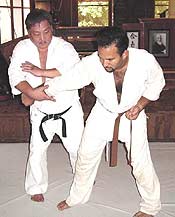 |
Roy Suenaka a long time student of Soken and teacher
of Matsumura Seito Hakutsuru Shorin Ryu Karate-do demonstrates
one of Soken’s typical trapping and takedown techniques (here,
an arm bar). Soken’s karate included a lot of trapping and
capturing techniques (torite) combined with countering and jujutsu-like
control methods. |
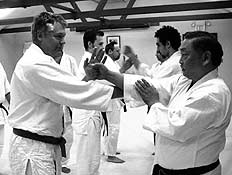 |
Soken also taught two man drills where partners would practice
exchanging various techniques back and forth in a continuous fashion.
Here Suenaka Sensei practices a two man punch and block drill with
Christopher Caile. |
Karate is much more than simple punching and kicking and blocking. It
is the study of weaponry and of grappling. Weaponry and empty hand fighting
go together. How can you learn about defending against a weapon unless
you are familiar with what the weapon can do?
Interviewer’s Note:
Soken-sensei used the Spanish word for wrestling when describing this
art-form but I felt that a more apt term would
be grappling - much like Japanese-style jujutsu. He stated that many
people often referred to the Okinawan grappling arts as Okinawan-style
wrestling mainly because it was never systematized and looked like
a free-for-all form of fighting.
As a youngster on Okinawa (Soken),
grappling was taken very seriously and it was not uncommon for individuals
to suffer broken arms and legs
as a result of taking part in this light form of entertainment. (Soken-sensei
used the terms "te-kumi" (1) or "gyaku-te" (2) as
identifying this old Okinawan art form) Interviewer’s note: The danger of reminding Soken-sensei of the "old
methods of playing" was that he would often stand up, grab you,
and then apply one of these painful methods of common people entertainment
- he enjoyed watching an American "squeaking like a mouse who
had been stepped on."
Grappling is an old Okinawan custom that
is commonly practiced in all villages. In America, the children played
at "cowboys and indians." In
Okinawa we played by grappling with each other. We would have contests
for grapplers in every village and one village would pit their best
grapplers against all comers. It was very exciting.
Some people see the grappling and call it Okinawan jujutsu but this
is not right. It is the old method called "ti" (often written
as ‘te.” When pronounced in the old dialect of Okinawa
it sounds like the word "tea"). Ti practice was very common
during the Meiji / Taisho era (turn of the century) but with the Japanese
influences, these methods have almost disappeared.
Estrada: Sensei, any recommendations for us -- Americans?
Soken Sensei: Yes, but you won't like it! Americans
want to learn too much, too fast. You want more this and more that.
You have a life time
to learn. Learn slowly. Learn correctly. Look. Listen. Practice, practice,
practice. Don't be a rash American, but a smart American. Never be
in a hurry to learn, OK? Learning in a hurry can cause pain. Do you
know about pain? Let me show you!
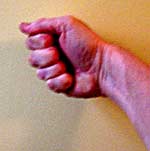 |
Soken used the thumb to hit sensitive pressure points
on the body – the hand position shown here. Estrada recounts
that when Soken demonstrated these techniques on him the targets
included under the arm (arm pit area), floating ribs, the throat
(slowly striking the "V" area and the jabbing your head
back, the solar plexus, the inside of the thigh, and also the middle
of the forearm (on the palm side) which caused the hand to go numb. “It
was very scary!” recounts Estrada. |
Interviewer’s Note: At this time, Soken demonstrated
basic "ti" methods
involving the use of the "sharp forearm bone" and the "thumbing" methods.
All of them hurt - a lot! He had an uncanny command of the human anatomy
and would use the thumb to hit the various nerves in the shoulder, the
forearm and the sides of the body. He laughed a lot when doing this -
he really enjoyed grappling. (3) A number of techniques resembled aikijujutsu
movements and instead of moving in on the opponent, he would step backwards
and would use his body weight to increase the power of the technique.
(4) He would always block using what he called a "double bone block" and
counter with a thumb technique or a grappling technique that took you
to the ground. Soken stated that he could drive an individual through
the ground or just simply throw him on the ground - either way, the opponent
was at a distinct disadvantage. He could then subdue you with techniques
like kicks or move away from the confrontation.
Estrada: Sensei, your kata is very distinct and beautiful to see. I have
a question that has been bothering me since the Okinawan Expo. Remember
when we saw the bo fighters in Nago? They used the names of many of the
kata that are practiced today but they are very different. The only thing
that appears to be the same is the name.
Soken Sensei: Yes, they are the same and they are not the same. You say
you lived on Okinawa for five years but you cannot understand the Okinawan
people. In the old days, when we were really Okinawan and not Japanese,
many of the old people were not smart -- or as smart as they are today.
They did not travel, they did not watch TV, many never left their villages
unless they had to. What we did have was festivals... village festivals.
Everyone would come and watch and learn.
These village people would watch the other fancy city people practice
their ti or their methods of weaponry. Say, like... well, ... Yes, a
kata that they knew or practiced had a number of movements. They come
to the city and see city kata with some of the same movements. The city
kata had a name... and maybe their kata did not have a name. So, they
would go back and ... yes, you now understand. They would name their
kata after the city kata because they had a few of the same movements.
Some of their kata had five or maybe ten movements. Taira, my friend,
would go to the village and learn these kata. He says that he learn 500
kata this way! Wah! He says that this is true but he also likes to tell
stories. Some of these kata had only 3 or maybe 5 movements. 500 kata,
yes, now that is funny but he was a history collector. He knew them but
he didn't understand them.
Estrada: Was Taira a friend or student? He is very famous for his weaponry
in Japan.
“…in good karate...
movements are quick, like a mongoose. If you are slow, you
can die.” |
Hohan Sensei: Yes, Taira... he knew a lot of kata, huh. Huh, huh, huh...
Yes, he is dead, you know that. He would watch my kata all the time and
try to learn my tsuken style stick. But I would trick him and change
the kata, wah!! ... just like that. He would still come back and look
some more in the hopes of being able to take it back. When we both were
young -- our karate was very good. When we both got old, our weaponry
was good.
Why do you want to know these things -- these old ideas, these old
ways. Their old value was to survive a challenge match. You punch me
and I will show you ... good karate means you also test yourself through
pain. Like pain... in good karate... movements are quick, like a mongoose.
If you are slow, you can die. If you are quick, then there is a chance
that you and your family will live.
Estrada: Yes, fighting must have been very different at the beginning
of this century.
Soken Sensei: Yes, you don't know these old days. In a fight... if
you would lose, the lost would be suffered by your family. They could
die. You would work hard to support the family working all day. If
you were injured or killed while fighting, then your family would starve...
maybe even die. Okinawa life was very hard.
Now, the young people want to be Japanese. They don't speak the Okinawan
language. They are lazy. They do not respect old people, they have
no pride in being Okinawan. Yes, we are a poor country but that is
no excuse in putting our culture in the dark and saying we are someone
that we are not. This is no good.
The second interview ends here. Sensei's mind begins to wander and he
begins to get angry. I believe it has to do with painful, old memories
that are brought up by the questions.
Interviewer’s Note: A number of individuals have managed to obtain,
borrow, or copy the above interview and have passed it off as being their
own work. It is sad that they would do this and hopefully they will repent
or atone for their infringement on my work. If not, then the words "karate
is meant to develop one's character, although it does not guarantee it" truly
has meaning. This makes me sad.
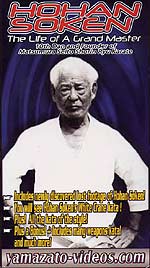
(FYVS-DVD-65)
$39.95
(Plus $5 Shipping
within the US)

|
Hohan Soken - The Life of a Grand Master
This historic video is a documentary on Hohan Soken, 10th Dan
and founder of Matsumura Seito Shorin Ryu Karate. This video
includes “Newly Discovered- Lost Footage” of Hohan
Soken as well as a biography of Soken Sensei detailing his life
in Karate Do. Also shown is rare historic footage of Soken Sensei
performing the kata: Naihanchi 1-3, Seisan, Chinto, Kusanku,
Gojushiho, Rohai, Tsuken bo, Kama Kusari and Hakutsuru, the closely
guarded secret White Crane kata of Matsumura Seito Shorin Ryu.
Additionally, the video includes rare footage of some of Soken
Sensei’s top students performing in Okinawa in the 1960s
and much more! This documentary style video is a piece of history
and brings the past to life! It preserves the teachings of a
highly respected Okinawan Grand Master whose legacy was to bring
karate from a bygone age into the modern era. A must for the
serious martial arts collector.
|
|
About The Author:
Estrada is a well know teacher, historian and writer on the martial
arts and is considered by many as one of the most knowledgeable authorities
on modern Okinawan history. He began training in Okinawan karate-do at
his local YMCA in 1960. In 1963 he joined the US Military and served
in Japan and Okinawa. Later he was re-assigned to Washington, DC, and
worked as a translator at the Pentagon for two and one half years. In
1972 he was promoted to shihan by the Zen Nippon Karatedoh Renmei (All
Japan Karatedoh Association) in Okinawa Seito Karatedoh. In 1973 he also
was promoted to shihan by Nakazato Shugoro Sensei in Okinawa Shorinryu
Karatedo (Chibana-ha). Has been an active teacher of Chibana-ha Shorinryu
since 1970 and has taught in Argentina, Mexico, England, Germany, Spain,
Ethiopia and Canada. Presently he teaches Chibana-ha Shorinryu in Michigan.
Professionally he is a retired Probation Officer supervisor (31 years)
and now works full time as a court appointed Fiduciary. Over a period
of 30 years he has researched karate and interviewed a wide assortment
of well known Okinawan karate teachers. He has authored numerous articles
for a variety of martial arts publications and as well as a series of
15 booklets based on his research. His most current project is to transfer
500+ VHS videos of Okinawan karate-do training and demonstrations to
DVD. Next year will be the transferring of 300+ rolls of 8mm and super
8mm to DVD.
|